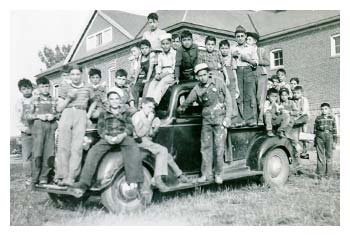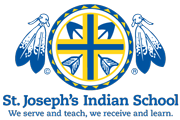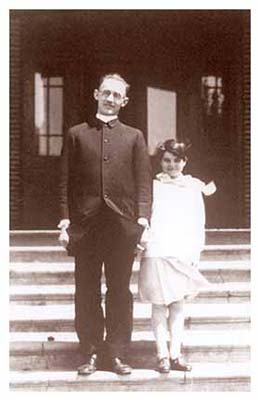Home » SJIS Timeline
Over 90 years serving Lakota children

It is difficult to conceive, walking the grounds of St. Joseph's Indian School, how many trials the small educational facility has endured since 1927.
The blue-green stretch of Missouri River here offers no hint of the dust storms and grasshopper plagues of the Great Depression. The tall trees catching the morning sun don't speak of the tornadoes of 1930 and 1931. And, the happy laughter of children playing makes it hard to remember the crackle of fires or bang of hammers rebuilding through the years.
Click the links below and travel back into history and learn the story of St. Joseph's Indian School.
- 1923
Fr. Henry Hogebach, SCJ came to the US
Fr. Henry Hogebach, SCJ came to the US from Germany. His ministry led him to the Lower Brule Reservation in South Dakota.
- Spring 1927
Fr. Hogebach received permission to purchase the Columbus College
Fr. Hogebach received permission to purchase the Columbus College campus at Chamberlain, South Dakota for $40,000.
- Fall 1927
Fr. Hogebach opened St. Joseph's Indian School

Fr. Hogebach opened St. Joseph's Indian School with 53 Lakota boys and girls.
In the following years, the school saw many hard times, but through God's grace and Fr. Hogebach's dedication school opened every fall.
Through the gifts from many generous friends, Father Hogebach was able to obtain enough supplies to meet the needs of the children and Benedictine Sisters who worked there.
Much of his time was spent raising funds to keep the school open; donations of clothing, shoes, medication and other supplies were greatly appreciated and well-used … just as they are today.
Over 90 years later, St. Joseph’s Indian School serves 200 Lakota boys and girls, providing them with a safe, stable environment that responds to the needs of the whole child — mind, body, heart and spirit.
- November 28, 1929
Thanksgiving week was a busy one at St. Joseph's. Two government doctors and a nurse paid us a visit to look after the health of the children. Six had their tonsils removed and five had their eyes operated on for Trachoma. All operations proved successful even though the little patients could not see what they were eating and the tonsil patients were not able to swallow.
- January 3, 1930
Our laundry building was destroyed by fire. The priest's dining room was taken over for the laundry. Today is washday and since it has been rather cold for a long time, all the water lines leading to the building are frozen. The big boys are busy thawing them out with blow torches. It is a real calamity to be without water. Our whole water system ought to be changed, but our empty treasury forbids even such necessary improvements.
- 1934-1935
The depression is at its peak and times are hard. In the spring Sr. Pauline took sick and had to be taken to the Pierre Hospital. She recovered somewhat, but before the new school year opened the Lord called His faithful handmaid home. Sister Cecilia and Helen Durkin were quarantined for several weeks after contracting scarlet fever.
Many of the children were undernourished and sickly. In November we sent one little girl away because her condition was a danger to the other children with whom she associated. She had neither parents nor home. An old Indian lady took her, but she was very poor and had not much herself. We tried everything to get the child into a hospital or sanitarium. We had no success. The girl developed tuberculosis and died three months later.

